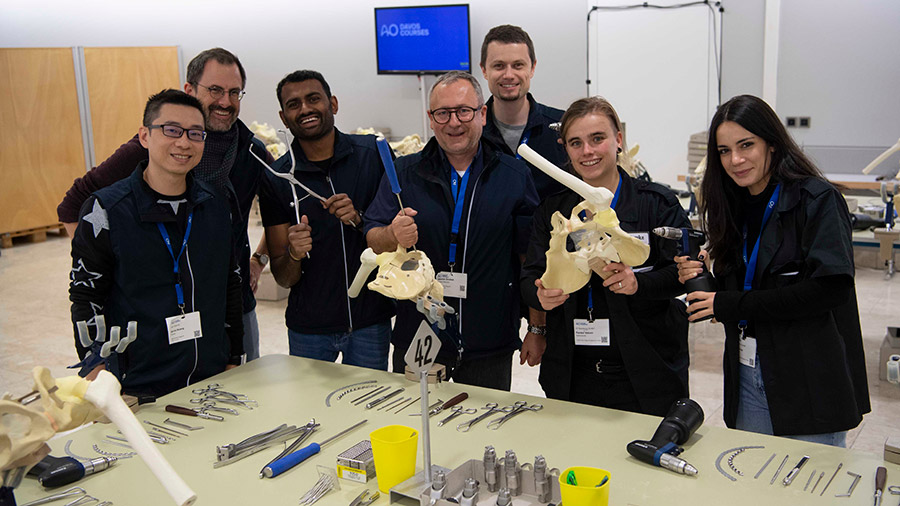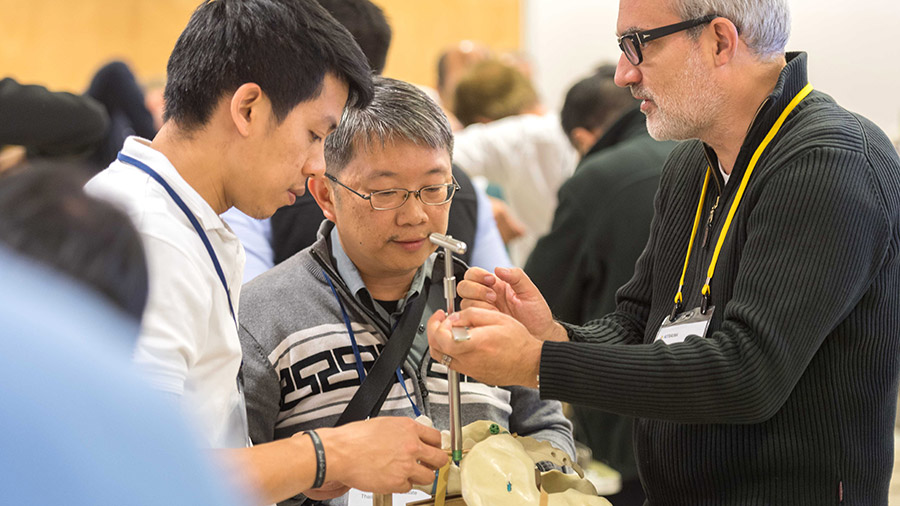AO Trauma Course—Pelvic and Acetabular Fracture Management
Surgeons participating in this course will learn how to address acute management of pelvic ring and acetabular injuries; how to evaluate, diagnose, classify, and determine appropriate timing and indications for interventions. They will be able to apply knowledge and skills in selection and performance of the surgical approach for specific injuries and definitive reconstruction of complex fractures.
Participants should be fully trained orthopedic and/or trauma surgeons with subspecialty interest in the treatment of pelvic and acetabular fractures. They must have already completed the AO Trauma Courses—Basic Principles and Advanced Principles of Fracture Management.
Why you should choose this course
Top national, regional, and international faculty
2-3 days in duration
For surgeons who already treat pelvic and acetabular fractures
Network with colleagues from all over the world
CME credits
Course content
-
Course modules
- Module 1—Pelvis: patient assessment and acute treatment
- Module 2—Pelvis: decision making and definitive treatment of pelvic ring injuries
- Module 3—Pelvis: special clinical situations
- Module 4—Acetabulum: Acetabular injury assessment
- Module 5—Acetabulum: Acetabular decision—making and treatment
- Module 6— Acetabulum: Surgical approaches
- Module 7— Acetabulum: special topics
- Module 8—Definitive management of complex pelvic ring injuries*
- Module 9—Special clinical situations and salvage of pelvic ring injuries*
- Module 10—Management of complex acetabular fractures*
- Module 11—Special clinical situations in acetabular fractures*
- Module 12—Surgical approaches with or without fixation on anatomical specimens*
*In selected courses. Check your chosen date and location for the full program.
-
Featured lectures and sessions
- Radiographic (x-ray and computed tomography) assessment and classification of pelvic ring injuries
- Acute management of pelvic ring disruption- clinical assessment, hemorrhage control and resuscitation
- Expert panel—interactive discussion with cases
- Demonstration of pelvic binder and sheet application
- Demonstration of C-clamp
- Treatment of anterior pelvic ring lesions
- Posterior lesions—treatment of SI dislocations and SI fracture dislocations
- Sacral fractures—techniques of reduction and fixation with iliosacral screws, tension band plating and lumbopelvic fixation
- Indications and techniques for lumbopelvic fixation
- Long-term results of pelvic fractures
- Evaluation and treatment of pelvic insufficiency fractures
- Salvage, late reconstruction of nonunion and malunion
- Radiographic assessment/interpretation including classification
- Technique to draw acetabular fracture on pelvic model from radiographs
- Decision-making—indications and timing for operative treatment
- Decision-making—choice of approach for operative treatment
- Kocher-Langenbeck approach—indications and techniques of reduction and fixation
- Ilioinguinal approach—indications and techniques of reduction and fixation
- Anterior intrapelvic (modified Stoppa) approach—indications and techniques of reduction and fixation
- Gibson approach with trochanteric flip osteotomy and dislocation— indications and technique
- Pararectus approach—indications and techniques
- Indications for combined (anterior and posterior) approaches
- The extended iliofemoral approach—indications and techniques
- Acetabular fractures with concomitant pelvic ring injuries—planning of approaches and sequences for reduction and fixation
- Femoral head fractures
- Acetabular fractures in the geriatric patient
- Primary hip arthroplasty for acetabular fractures
- Late treatment of acetabular fractures
- Clinical outcomes of acetabular fractures
- When things don’t go well—lessons learned
- Strategies for career learning in pelvis and acetabular surgery
-
Practical excercises
- Stabilization of the pelvic ring with an external fixator
- Insertion of iliac crest and supraacetabular Schanz pins
- Reduction and plating of symphysis disruption
- Sacroiliac joint dislocation
- Sacral fractures- iliosacral screw and tension band plate
- Sacral fractures-bilateral lumbopelvic fixation with transiliac transsacral screw
- Both column fracture
-
Small Group discussions
- Acute management, assessment, and classification of pelvic ring injuries
- Radiology, classification, and treatment of acetabular fractures
- Complex cases of pelvis and complications
- Complex cases of acetabulum and complications
-
Anatomical Specimen Lab*
- Kocher-Langenbeck approach
- Posterior approach to the pelvic ring (including Wiltse)
- Master table demonstration-trochanteric osteotomy and surgical hip dislocation
- Ilioinguinal approach (supine)
- Anterior approach to the sacroiliac joint
- Middle window
- Pfannenstiel component (modified Stoppa)
- Pararectus (supine; same side)
Course details may be subject to change. Please check your chosen date and location for the detailed program.
Target audience
- Surgeons whose primary need is to learn or improve skills in pelvic and acetabular surgery, from various training paths:
- Orthopedics: sub-specialists, fellowship trained, pelvic-acetabular surgeons, general training
- Trauma: fellowship training, general training
Competencies
- Perform emergency clinical assessment with specific focus to pelvic ring and hemodynamic instability. Apply ATLS protocols
- Recognize when and how to perform emergency stabilization
- Perform secondary full patient assessment
- Order and interpret imaging evaluations
- Plan treatment—acute and definitive
- Assess the impact of comorbidities and concomitant injuries
- Plan and perform approach, reduction, and fixation
- Prevent, identify, and address complications
- Adapt treatment according to specific bone structure / quality
- Delineate and perform postoperative management protocol
- Perform salvage techniques
What does competency-based curriculum development mean?
Pelvis and acetabulum education taskforce

Miguel Angel Giraldez (ES)
Term: 2022–2024

Sherif Ahmed Radwan Khaled (EG)
Term: 2023–2025

Ismail Hadisoebroto Dilogo (ID)
Term: 2024–2026
See a full list of all regional program contributors and past international program editors.
Not the right course?
Find our list of all curricula courses here.




